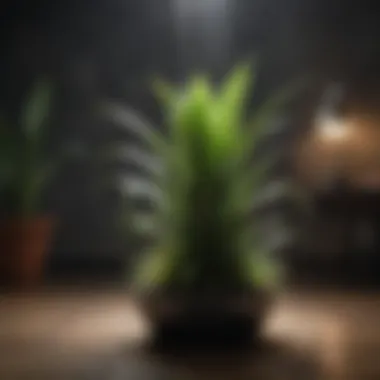Reviving Your Snake Plant: Essential Care Tips


Intro
The snake plant, scientifically known as Sansevieria trifasciata, is a beloved houseplant due to its striking appearance and remarkable resilience. However, even the hardiest of plants can exhibit signs of distress if not cared for properly. This guide serves as a comprehensive resource for understanding the intricacies of reviving and sustaining the health of the snake plant.
In this exploration, we will delve into the symptoms that indicate a snake plant may be struggling, the environmental factors that contribute to its well-being, as well as practical care techniques and preventive measures. Whether you are a novice homeowner or a seasoned plant enthusiast, the insights provided in this guide will empower you to nurture and restore the vitality of your snake plant.
By focusing on the specific needs of this resilient houseplant, you will soon discover that with the right knowledge, creating a thriving indoor green space is well within your reach.
Foreword to the Snake Plant
The snake plant, also known as Sansevieria, holds a significant place in the realm of indoor gardening and plant care. This section serves to illuminate the unique qualities of the snake plant and its role in enhancing living spaces. Understanding the basics of this plant lays the groundwork for effective care and revival practices later in the article.
Having a diverse range of attributes, snake plants are favored by many. They thrive in various environments and require minimal maintenance. This adaptability makes them ideal companions for homeowners, especially those with busy lifestyles. Observing the characteristics and benefits of this plant is essential, as they directly inform the care techniques discussed in later sections.
The snake plant's ability to purify indoor air is another reason for its popularity. It absorbs toxins and releases oxygen, contributing to a healthier home environment. As more people become conscious of air quality, the snake plant becomes a relevant choice. Therefore, this section is not merely introductory; it sets a foundation for understanding how this plant can enrich one’s home.
Characteristics of Snake Plants
Snake plants are characterized by their distinctive long and upright leaves, which are spear-shaped. The leaves can vary in color, typically featuring shades of green, sometimes with yellow or white edges. It is not uncommon for some varieties to display variegated patterns that enhance their aesthetic value.
These plants are also succulent, which means they have the capacity to store water within their leaves. This feature enables them to endure periods of drought and requires infrequent watering, making them a preference for many indoor plant enthusiasts. Furthermore, the snake plant has an impressive resilience to neglect, proving to be a great choice for both novice and experienced gardeners.
Common Varieties of Snake Plants
There are several notable varieties within the snake plant family, each possessing its own unique appearance and growth habits. Common types include:
- Sansevieria trifasciata: Often categorized as the classic snake plant, it features long, sword-like leaves with a bold green hue and distinctive horizontal stripes.
- Sansevieria cylindrica: This variety stands out with its round leaves that grow upright. It adds a unique texture to plant collections.
- Sansevieria moonshine: Known for its silvery-green leaves, this variety brings a modern touch to any space.
Each of these varieties not only contributes to the diversity of the indoor landscape but also offers varying degrees of care needs and growth patterns. As such, understanding these differences is crucial for effective plant care and revival practices.
"Choosing the right variety of snake plant can play a crucial role in your overall success with indoor gardening."
These introductory elements emphasize the importance of the snake plant in both aesthetics and air quality. Recounting these characteristics allows readers to appreciate the intricacies involved in maintaining the health of such a resilient plant.
Identifying Issues with Your Snake Plant
Trouble can creep up on your snake plant before you even realize it. Identifying issues quickly is critical to maintaining its health and vibrancy. This section focuses on observing signs of distress, which often manifest in foliage and overall plant appearance. By recognizing these signs early, you can implement targeted remedies. This decreases the risk of permanent damage and ensures your plant thrives in its environment.
Signs of Overwatering
Overwatering is one of the most common issues for snake plants. This indoor plant prefers drying out between waterings. If you notice leaves turning yellow and soft, this is a strong indicator of trouble.
- The texture of the leaves is mushy, indicating excessive moisture in the soil.
- There may be a foul smell coming from the soil, as roots begin to rot.
- In severe cases, black spots can appear on the leaves, suggesting root rot.
Tips for confirming this condition include checking how moist the soil feels just below the surface. If it remains soggy, it's time to rethink your watering schedule.
Signs of Underwatering
On the other hand, underwatering can also cause distress. Snake plants can survive through dry periods but prolonged neglect leads to evident signs. Key indicators include:


- Wrinkled or shriveled leaves that look discolored.
- Brown tips on the leaves signify dehydration.
To remedy underwatering, gently assess the dryness of the soil. If it needs moisture, it's essential to water thoroughly until excess drainage occurs. Just remember, consistency is the key.
Pest Infestations
Pests can pose a serious threat to the health of your snake plant. Common culprits include spider mites and mealybugs. Look closely for tiny webs or cotton-like substances around the plant.
- Check for tiny insects nestled in the foliage.
- Pests often cause yellowing leaves or spots. Regularly inspect the leaves and base to catch infestations early.
If you find pests, consider wiping leaves with a damp cloth. Horticultural oils can also be effective in treating infestations without harming the plant.
Leaf Discoloration
Leaf discoloration can be a complex issue for snake plants. Various factors contribute, including environmental stress and nutrient deficiencies. Pay attention to the following signs:
- Yellow leaves may indicate overwatering.
- Brown tips result from underwatering or low humidity.
- Dark, mushy patches signal rot.
Monitoring foliage color can help you determine the underlying issue. Adjust care accordingly to restore the natural beauty of your snake plant.
Assessing the Environment
Assessing the environment where the snake plant resides is crucial for its revival and long-term health. The right environmental conditions can significantly influence the growth and durability of the snake plant. Snake plants are known for being hardy, but they still have specific needs that, when met, promote optimal growth. By understanding factors such as lighting, temperature, and humidity, homeowners can create a nurturing space that allows their plants to thrive. This section will explore these elements in detail, emphasizing how each aspect can affect the health of the plant.
Optimal Lighting Conditions
Snake plants prefer bright, indirect light but can tolerate low light levels as well. Evaluating the lighting in your home is the first step in ensuring your snake plant's health.
Some key points about the lighting needs include:
- Bright, Indirect Light: This is the ideal condition for snake plants. Placing them near a window that doesn't receive direct sunlight can help enhance their growth.
- Low Light Tolerance: While snake plants can survive in low light, their growth may slow down, and their leaves may lose some vibrancy.
- Avoid Direct Sunlight: Exposure to direct sunlight for extended periods can scorch the leaves, leading to damage.
Overall, experimenting with different placements can help in finding the best spot for your snake plant in the home.
Temperature Preferences
Temperature plays a significant role in the overall well-being of snake plants. These plants thrive in a warm environment but can adapt to a range of temperatures.
- Ideal Range: Snake plants do well in temperatures between 60°F to 80°F (15°C to 27°C). Keeping them in this range will keep them healthy and growing.
- Sensitivity to Cold: They are not frost-tolerant, so exposure to temperatures below 50°F (10°C) can be harmful. Indoors, make sure they are away from drafty windows or doors.
When assessing temperature conditions, consider both day and night fluctuations. Simulating a stable environment will keep the plant happy and vibrant.
Humidity Levels
Snake plants are resilient but can benefit from proper humidity. Understanding the humidity needs will impact their health and growth positively.
- Preference for Low Humidity: They typically thrive in low to average indoor humidity levels. Too much humidity can encourage fungal issues and pests.
- Special Consideration During Winter: Indoor heating can decrease humidity. Occasionally misting the leaves or placing a small humidifier nearby can help maintain a balanced atmosphere for the plant.
Overall, while snake plants do not demand high humidity, some balance can support their overall health.


Important Note: Assessing the environment regularly can help diagnose potential problems early, allowing timely interventions to ensure the longevity of your snake plant.
Reviving Techniques for a Snake Plant
Reviving a snake plant involves several important techniques that can restore its health and vitality. Understanding these techniques is essential for both new and seasoned plant owners. The right approach can make significant impact on the plant's recovery. These methods not only address existing issues but also set the stage for ongoing care, which is critical for the longevity of the plant.
Adjusting Watering Practices
Adjusting watering practices is one of the first steps in reviving a snake plant. Snake plants are succulents, which means they prefer dry conditions. Overwatering is a common issue that can lead to root rot. The goal is to establish a sound watering schedule. Wait until the soil is dry to about two inches deep before watering. When you do water, soak the soil thoroughly, ensuring that excess drains out.
Use a well-draining potting mix designed for cacti or succulents. This type of soil will help prevent water accumulation, which is often harmful. Remember to adjust the frequency of watering based on seasonal changes. In winter months, plants typically require less water due to reduced growth.
Soil Amendments
Soil amendments play a vital role in the health of a snake plant. For rejuvenation, it is often beneficial to use a potting mix that allows for proper drainage. Standard potting soil retains too much moisture. Adding components like perlite or sand can enhance drainage and air circulation around the roots.
Another consideration is the nutrient profile of the soil. While snake plants are not heavy feeders, incorporating organic fertilizers occasionally can promote better growth. Mix slow-release fertilizers into the soil when repotting or top-dress with a diluted liquid fertilizer during the growing season.
Repotting Strategies
Repotting a snake plant can be an effective method to revive it. Over time, plants may become root-bound, which restricts growth and nutrient absorption. Choose a pot that is only slightly larger than the current one. This limits excess soil that could retain moisture. When repotting, gently loosen the roots before placing the plant in the new pot.
Ensure that the new pot has drainage holes. After repotting, do not water immediately; allow the plant to adjust for a week. This helps minimize the risk of overwatering and aids in root recovery.
Treatment for Pests
Pest infestations can hinder the recovery of a snake plant. Common pests include spider mites, mealybugs, and aphids. Regularly inspecting the plant for these issues is a good practice. If you notice any pests, treat them promptly with insecticidal soap or neem oil. Both remedies are effective against a range of pests without harming the plant.
For a serious infestation, consider isolating the plant to prevent spread to other plants. Thorough cleaning of the plant leaves with a neem oil solution can help in controlling pests. Be diligent in monitoring for signs of infestation, as early intervention is often key to recovery.
Long-term Care for Snake Plants
Long-term care for snake plants is crucial for maintaining their health and aesthetic appeal. This section outlines best practices that support their resilience. Proper care reduces stress and prevents common issues like rot and pest infestations. Investing time in understanding these practices will yield healthier plants, enhancing indoor environments with vibrant greenery.
Routine Watering Schedule
Establishing a routine watering schedule is essential. Snake plants are known for their drought tolerance, so overwatering is a common mistake. It is advisable to water the plant thoroughly, then allow the soil to dry out at least halfway before the next watering. Generally, watering every two to three weeks is suitable, but this may change with seasons.
Some key tips for watering include:
- Check the soil: Use a finger to feel if the soil is dry. If it is still moist, delay watering.
- Adjust for seasons: In winter, the plant requires less water. Monitor the climate closely.
- Consider the pot: Ensure pots have drainage holes, as stagnant water can lead to root rot.
Fertilization Practices
Fertilization provides nutrients that snake plants need, especially during the growing season which is spring and summer. It is recommended to use a balanced, diluted houseplant fertilizer once every month or two. Over-fertilization should be avoided as it can lead to salt buildup in the soil.
Guidelines for fertilization include:
- Choose the right type: Look for a liquid or water-soluble fertilizer with equal ratios of nitrogen, phosphorus, and potassium.
- Apply during growing season: Do not fertilize in fall or winter when the plant’s growth slows.
- Dilution is key: Always dilute the fertilizer to half strength to prevent root burn.


Monitoring Growth Patterns
Monitoring growth patterns can help identify the plant’s needs. Snake plants typically grow taller, while they sometimes produce new offsets or pups. Regular observation allows for adjustments in care practices.
Points to consider:
- Growth inspection: Observe the height and health of leaves. If growth is stunted, reassess light conditions or water frequency.
- Pup formation: Pups signal a healthy snake plant. Separate them for propagation when they are a few inches tall.
- General health check: Check for leaf discoloration or curling, as these could indicate poor care conditions.
Regular evaluation of plant health ensures long-term thriving. Through consistent watering, judicious fertilization, and close monitoring, one's snake plant can grow robustly in any indoor space.
Preventive Measures to Avoid Plant Distress
Preventive measures are essential in sustaining the health of snake plants. These steps ensure that potential issues are addressed before they escalate into serious problems. An ounce of prevention can save a mature plant from unnecessary stress and damage. When preventive actions are integrated into your care routine, you will foster a resilient living space. This ultimately enhances both the longevity and aesthetic appeal of your plant.
Choosing the Right Location
Finding the appropriate location for your snake plant is paramount. Snake plants thrive in a wide range of conditions, but a few specific factors should be considered. Firstly, they prefer indirect sunlight. A spot near a window that receives filtered light works best. Direct sunlight can scorch the leaves, leading to discoloration and damage.
Secondly, consider airflow. Snake plants enjoy good ventilation but can be sensitive to drafts. Avoid placing your plant in direct line with heating or cooling vents.
Lastly, temperature is key. Snake plants prefer temperatures between 60°F to 80°F (15°C to 27°C). Staying within this range will prevent stress, helping your plant to remain healthy and vibrant.
Understanding Seasonal Changes
Seasonal changes play a vital role in the care of your snake plant. In winter, light levels decrease, necessitating a shift in care practices. During this time, reduce watering frequency, as the plant goes dormant. It is essential to observe your plant and adjust care routines accordingly.
In contrast, spring and summer bring longer days and increased growth activity. It is during these months that your snake plant will benefit from a bit more attention. More light encourages growth, yet care must be taken not to overwater. A careful balance is crucial throughout the seasons.
Best Practices for Indoor Plants
Implementing best practices for indoor plants ensures a thriving environment. For snake plants, consider the following recommendations:
- Watering Schedule: Wait until the soil is dry before watering. This prevents overwatering, a common issue that leads to root rot.
- Soil Choice: Use well-draining potting soil. A mix designed for succulents can be particularly effective.
- Monitoring for Pests: Regularly check for signs of pest infestations. Early detection allows for prompt treatment, minimizing potential damage.
- Humidity Control: While snake plants tolerate low humidity, avoid placing them near excessively dry areas, such as radiators.
"Regular maintenance and preventive care make snake plants one of the easiest houseplants to keep healthy."
By following these preventive measures, you will create a conducive environment that promotes health and growth. This reduces the likelihood of encountering issues in the future, allowing for a more enjoyable experience in indoor gardening.
Closure
In concluding this comprehensive guide on the snake plant, it becomes evident that understanding the needs and issues surrounding this resilient houseplant is crucial. Observing its characteristics, recognizing distress signals, and providing appropriate care can markedly influence its health and growth. This article sheds light on the necessary practices that ensure the snake plant thrives in various environments, making it a favorable choice for many homeowners and plant enthusiasts.
Recap of Key Strategies
To summarize the essential strategies discussed:
- Identifying Issues: Recognizing signs of overwatering, underwatering, pest infestations, and leaf discoloration.
- Assessing Environment: Ensuring optimal lighting conditions, appropriate temperatures, and humidity levels to support the plant's growth.
- Reviving Techniques: Adjusting watering practices, amending the soil, repotting, and treating pests as needed.
- Long-term Care: Following a routine watering schedule, practicing correct fertilization, and monitoring growth patterns.
- Preventive Measures: Selecting the right location, understanding seasonal changes, and employing best practices for ongoing care.
These strategies play a significant role in not just reviving but also sustaining the vibrancy of the snake plant.
Encouragement for Plant Enthusiasts
For those who cultivate their green spaces, dedication and patience remain indispensable. Whether you are an experienced gardener or just beginning your plant journey, remember that each plant has a unique rhythm. Do not be disheartened by challenges; instead, view them as opportunities to learn. The snake plant is known for its hardiness, which serves as an ideal example of resilience in plant care. With an integrated approach to the aforementioned strategies, you can foster a thriving environment for your snake plant.
"Successful plant care is less about perfection and more about understanding and adapting to individual needs."
Take pride in your efforts and enjoy the rewarding process of nurturing a plant that not only beautifies your space but also enhances the overall atmosphere. Through the right techniques and mindfulness, the journey with your snake plant can be both fulfilling and enlightening.



